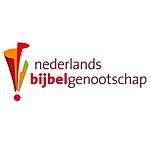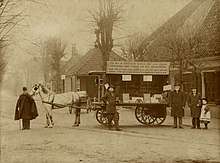Netherlands Bible Society
The Netherlands Bible Society (Dutch: Nederlands Bijbelgenootschap; NBG) is a non-denominational Bible society in the Netherlands devoted to translating, publishing, and distributing the Bible at affordable costs. The NBG is based in Haarlem and was formed on 29 June 1814 on the initiative of the British and Foreign Bible Society (BFBS).
Nederlands Bijbelgenootschap (NBG) | |
 | |
| Formation | 1814 |
|---|---|
| Purpose | Bible distribution, translation, advocacy, literacy, engagement, production |
| Headquarters | Haarlem, Netherlands |
Region | Netherlands |
| Affiliations | United Bible Societies |
| Website | bijbelgenootschap.nl |
History
After the establishment of the BFBS in 1804, Bible societies were set up in many European countries to facilitate the affordable publishing and distribution of the Bible, particularly in the wake of the Napoleonic Wars. This was only possible in the Netherlands after the withdrawal of the French occupation army over the course of 1813 after eight years of French domination and direct occupation. Local Bible societies were set up in the various provinces and they were united as the NBG in 1815. [1] The mission of the NBG was deliberately limited to the distribution of Bibles and literature with the work of evangelism being left to other agencies.
The initial activities of the NBG was to purchase and redistribute Bibles or portions of the Bible affordably to the public. In November 1815, the NBG reported:
- Purchased 2,208 copies of the New Testament and the Bible
- Received 1,894 copies of the same
- Distributed 1,608 copies of the same to prisoners, Sunday Schools, and the poor
Translation, publishing and distribution of the Dutch Bible

In 1847, the NBG decided to take up the work of publishing the Bible themselves. The version that was primarily distributed in the Netherlands then was the 1637 Statenvertaling (transl. State Translation, also known as the Statenbijbel or State Bible).
The NBG appointed two colporteurs in 1890 specially for distribution in the countryside where the Bible was often difficult to obtain by laypeople. This was initially done by pushcart and later evolved into using horse-drawn carriages and trucks. These "Mobile Bible Houses" became a hallmark of the NBG's distribution programme until it was eventually discontinued in 2002. [1]
NBG Translation
Over time the 17th century Statenvertaling had become less accessible to the general public due to the evolution and development of the Dutch language as well as the advances made in biblical scholarship. Earlier attempts in the 19th century to revised the Statenvertaling were not successful and in 1911 a group of scholars decided to embark on a new translation of the Bible in Dutch that would be translated from Greek manuscripts considered more reliable than the Textus Receptus while staying faithful to the idiomatic style of the Statenvertaling that the majority of Dutch Christians were familiar with.
In 1927, the NBG got involved in the project and eventually became the main sponsor and coordinator. Translators in the project were from the Protestant church in the Netherlands and represented the various theological streams within Protestantism. In 1939 the New Testament was completed and published and in 1951 the full Bible was published as the NBG Vertaling (transl. NBG Translation). [2]
Great News For You
A new English translation of the New Testament using the principle of dynamic equivalence had been published in 1966 by the American Bible Society. Entitled Good New For Modern Man: The New Testament in Today's English Version, it was targeted at people who did not have English as their first language as well as people who had limited exposure to church.
As Dutch society rapidly secularised after the Second World War, many felt that a translation based on similar principles was needed. This resulted in the publishing of the Groot Nieuws voor U (transl. Great News For You) translation of the New Testament, primarily as a result of the work of A. W. G. Jaake. [3]
Revised Statenvertaling
The NBG also commissioned a revised edition of the Statenvertaling by establishing a revision committee under Rev. C. A. Tukker. This revision was primarily a linguistic adaptation with modernised spelling used without any further substantial changes and was published in 1977 as the Statenvertaling 1977 (also known as the Tukkervertaling or Tukker Translation). [4]
Great News Bible
After the Second World War, the NBG started collaborating with the Roman Catholic Katholieke Bijbelstichting (transl. Catholic Bible Foundation; KBS) to translate and produce a modern Dutch language ecumenical translation of the Bible.
Efforts remain stymied by various reasons and it was decided to first publish an ecumenical translation using vernacular Dutch. This took off from the 1972 Groot Nieuws voor U translation of the New Testament and by 1983, the full Bible including the Deuterocanonical books was published in 1983 as the Groot Nieuws Bijbel (transl. Great News Bible). [3] This version was revised in 1996 to incorporate the latest scholarship as well as contemporary changes in Dutch spelling. [5]
New Bible Translation
As a result of a 1989 meeting of the Consultative Council on the Bible, a decision was made to translate and publish a completely new ecumenical translation. In 1993, the translation work began with the NBG, and the Vlaams Bijbelgenootschap (transl. Flemish Bible Society) representing the Protestants while the KBS and the Vlaamse Bijbelstichting (transl. Flemish Bible Foundation) representing the Roman Catholics. [6]
A complete formal ecumenical translation of the Bible was finally published in 2004 as the Nieuwe Bijbelvertaling (transl. New Bible Translation) and launched in Rotterdam by Queen Beatrix. [7]
Bible in Plain Language
In 2014, the NBG published the Bijbel in Gewone Taal (transl. Bible in Plain Language). This translation, started in 2006, is new translation in contemporary vernacular Dutch and the first copy was presented to King Willem-Alexander, the patron of the NBG, on 1 October 2014. [8]
Translation, publishing and distribution of the Bible in the East Indies
Not long after its establishment, the NBG also turned its attention to the distribution of the Bible in the Dutch East Indies. It started by reprinting the 1733 Leydekker Bible in Malay. In 1823, the NBG had also started its own initiative in translating the Bible into Javanese and other local languages of the East Indies. In 1826, the first NBG sponsored linguist and translator, Johann Friedrich Carl Gericke, was despatched to Java and he completed a translation of the whole Bible in Javanese in 1854. [9][1]
The NBG also sponsored other linguists and translators, including Herman Neubronner van der Tuuk (Batak), Nicolaus Adriani (Bare'e), Benjamin Frederik Matthes (Makassarese and Bugis), and Hendrik Kraemer. [9] In 1895, a New Testament in the West Timorese Roti language was published by the NBG. [10]
It was only after the establishment of the United Bible Societies (UBS) in 1946 and the Lembaga Alkitab Indonesia (transl. Indonesian Bible Society; LAI) in 1951 was the responsibility for translating the Bible into languages other than Dutch was transferred from the NBG to the UBS and LAI. [1]
Bibles and Bible portions translated and published by the NBG in the languages and dialects of the Dutch East Indies include:
| Year | Language | Portions | Primary Translator(s) |
|---|---|---|---|
| 1821 | Malay [9] | Revision of the 1733 Leydekker Bible | M. Leydekker |
| 1854 | Javanese [11] | Both the New and Old Testaments | J. H. C. Gericke |
| 1863 | Malay [9] [12] | New Testament in Low Malay | H. C. Klinkert |
| 1867 | Toba Batak [11] | Books of Genesis, Exodus, Canonical Gospels, and Acts of the Apostles | H. N. van der Tuuk |
| 1879 | Malay [11] [9] [12] | New and Old Testaments in High Malay | H. C. Klinkert |
| 1890 | Madura [11] | Canonical Gospels and the Acts of the Apostles | J. P. Esser |
| 1895 | Roti [10] | New Testament | |
| 1896 | Sangir [11] [13] | Canonical Gospels and the Acts of the Apostles | Clara Steller |
| 1900 | Makassarese [11] [14] | Both the New and Old Testaments | B. F. Matthes |
| 1901 | Bugis [11] [14] | Both the New and Old Testaments | B. F. Matthes |
| 1911 | Mentawai [11] | Gospel of Luke | A. Lett |
| 1913 | Nias [15] | Both the New and Old Testaments | W. H. Sundermann |
| 1928 | Karo Batak [11] | New Testament | J. H. Neumann |
| 1933 | Bare'e [13] | New Testament | N. Adriani |
| 1938 | Malay [9] [12] | New Testament | W. Bode |
| 1948 | Mori [11] | New Testament | K. Riedel |
The NBG today
In keeping with its goal of:
- Translating The Bible
- Making The Bible Available
- Increasing Engagement With The Bible
the NBG uses multiple platforms to increase Bible accessibility and literacy in the Netherlands, including the setting up of an online portal; debijbel.nl, that provides online resources for the study of the Bible. [16]
The NBG, as a member of the UBS, also works closely with other affiliated Bible Societies to produce modern translations of the Bible and improve distribution channels.
See also
External links
References
- "NBG - Geschiedenis" [NBG - History] (in Dutch). Netherlands Bible Society. Retrieved 26 April 2019.
- "NBG-vertaling 1951 (NBG51)". Youversion (in Dutch). Life Church. Retrieved 26 April 2019.
- Berends, Margot (May 2007). "Vijfentwintig jaar Groot Nieuws Bijbel" [Twenty Fives Years of the Great News Bible] (PDF). Met andere woorden (in Dutch). Haarlem, Netherlands: Nederlands Bijbelgenootschap. Archived from the original (PDF) on 4 July 2012. Retrieved 26 April 2018.
- Huurnink, Arjan (12 November 2008). "De Herziene Statenvertaling" [The Revised State Translation]. Bijbel en Geloof (in Dutch). Retrieved 26 April 2019.
- Groot Nieuws Bijbel met Deuterocanonieke Boeken (met aantekeningen) [Great News Bible with Deuterocanonical Books (Annotated)] (in Dutch). Hoeven / Haarlem, Netherlands: Katholieke Bijbelstichting - Nederlands Bijbelgenootschap. 1998. p. Preface. ISBN 978-906-126-781-2.
- "Over de NBV" [About the NBV]. debijbel.nl (in Dutch). Nederlands Bijbelgenootschap. Retrieved 26 April 2019.
- Groen, Jenny (27 October 2004). "Alles uit de kast voor de Nieuwe Bijbelvertaling" [Everything out of the closet for the New Bible Translation]. de Volksrant (in Dutch). Amsterdam, Netherlands. Retrieved 26 April 2019.
- Rhodes, Andrea (3 October 2014). "New 'Bible in plain Dutch' launched in Netherlands". United Bible Societies. Retrieved 26 April 2019.
- Soesilo, Daud (2001). Mengenal Alkitab Anda [Know Your Bible] (in Indonesian). Jakarta, Indonesia: Lembaga Alkitab Indonesia. ISBN 978-979-463-372-4.
- "het Evangelie van Lukas". Find-A-Bible. Forum of Bible Agencies International. Retrieved 26 April 2019.
- Kilgour, R (1939). The Bible Throughout The World: A Survey of Scripture Translations. New York City, USA: World Dominion Press. p. 171-176.
- Cermat, H. R. Alkitab: Dari Mana Datangnya? [The Bible: Where Did It Come From?] (in Indonesian). Jakarta, Indonesia: Lembaga Literatur Baptis.
- Abineno, Johannes Ludwig Chrysostomus (1978). Sejarah Apostolat Di Indonesia, Vol 2, Iss 2 [History of the Apostolate in Indonesia, Vol 2, Iss 2] (in Indonesian). Jakarta, Indonesia: BPK Gunung Mulia.
- Kruger, Dr. Th. Muller (1959). Sedjarah Geredja di Indonesia [History of the Church in Indonesia] (in Indonesian). Jakarta, Indonesia: Badan Penerbit Kristen, Jakarta.
- van der End, Th (1999). Ragi Carita 2 (in Indonesian). Jakarta, Indonesia: BPK Gunung Mulia. ISBN 978-979-415-606-3.
- "NBG - Missie" [NBG - Mission] (in Dutch). Nederlands Bijbelgenootschap. Retrieved 26 April 2019.